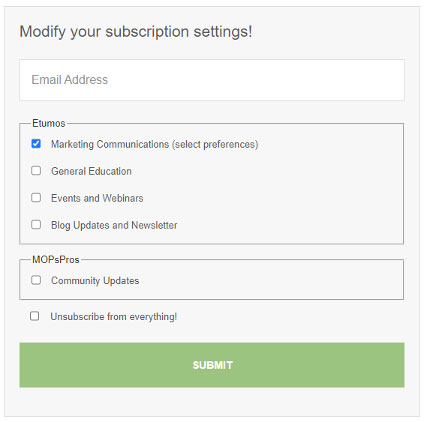A preference center is a valuable tool for improving audience targeting in marketing automation platforms such as Marketo, HubSpot, Account Engagement (formerly Pardot), and more. Providing your audience with the ability to select their preferences for the type of marketing content they receive from you will allow you to tailor your marketing messages to their specific interests and needs. Let’s dive into the best ways to improve audience targeting with a preference center.
What is audience targeting?
Audience targeting is the process of identifying a specific subset of your database that is most likely to be interested in your product or service. Often this looks like splitting your audience into demographic or firmographic categories, using data such as company size, industry, job title, or region. You may even use buyer personas for audience targeting, which narrows your audience down to a very specific set of criteria that your organization has determined as good signal markers that a lead is the right type of audience for your product or service.
You can take audience targeting one step further, however, by implementing a preference center.
What is a preference center?
A preference center is a simple webpage with a form that allows your email subscribers to customize their subscriptions and content preferences. The preference center will usually include a few different options that subscribers can select, such as types of content or products and services they’re interested in. This allows you to personalize the emails your subscribers receive to be relevant to their content preferences.

Why should companies improve audience targeting?
Audience targeting is a science. Done well, it can dramatically improve your marketing campaign efficiency and ROI. Why waste time and resources marketing a product or service to a lead that doesn’t want it, or doesn’t fit your ICP (ideal customer profile)? Basic audience targeting details can be gleaned from demographic and firmographic information – how many employees work at the company, what industry they work in, what region are they located in, what is their job title, what department they work in, etc. This information is helpful in determining if the lead would be a good fit as a potential customer.
Implementing a preference center is going to give you more information about what the lead is actually looking for. Are they interested in attending events? Do they just want to receive your industry newsletter? Is there a specific product or service from your lineup that they want to know more about? The benefit of information gathered from a preference center is you know the lead submitted that information themselves – you’re not making a generalization. You can send them tailored information based on what they signaled they want to receive. This is going to lead to better email engagement and fewer unsubscribes.
How to use a preference center to improve audience targeting:
Offer relevant content options
Don’t overwhelm your audience with too many options, but make sure the options you provide are a range relevant to their interests and needs. This will vary by industry and business, but the most common content options are usually categories including webinars & events, blog content & newsletters, product updates, and special offers/promotions. If you have multiple product offerings, you can set up selections for each product as well.
Make it easy to use
In tandem with keeping your options from being overwhelming, you want the format of your preference center to be clean, concise, and easy to use. Consider the user experience of filling out a form with multiple checkboxes or boolean fields. If you include a checkbox to unsubscribe from all, set up the form so all content options are unchecked if unsubscribe is checked. Pay close attention to the language you use with your checkbox labels, so there is no confusion about whether someone is opting in or opting out of your marketing emails.
Integrate it with your marketing automation platform
Most importantly, make sure the data collected from your preference center form flows back into your marketing automation platform. This is critical to be able to tailor marketing messaging based on the preferences your audience selected. You can even flow this data back into your CRM if you wish for it to be visible to your sales team to inform how they might engage with prospects.
With all of the above in mind, you can create a preference center that can improve marketing campaign efficiency and ROI by sending tailored information to the right audience at the right time.







